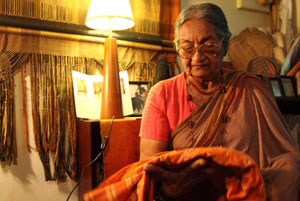Characterized by nuanced variations in colour and texture, Chandramani Thenuwara’s textiles are often subtle in design and complex in technical composition. Over the course of her career she has produced a rich body of work, ranging from the paintings of her youth to a vast array of textiles through her collaborations with weavers around the island.
 |
In workshops spread across the island, these weavers produced her designs through the Department of Small Industries, the Southern Provincial Council, Salu Sala, the National Handloom Centre and the Thalagune weaving village. Thenuwara insists that without her weavers and their ability to read her designs and translate them onto the loom, she could never have produced the textiles she did. When Theertha approached Thenuwara about organizing Woven Colour V, she expressed a strong desire that the exhibition be held not only to provide a retrospective of her work but also to celebrate and pay tribute to the hand weavers who brought to life the fabrics she designed.
Thenuwara’s life has been shaped by at least two cultural worlds and her textiles embody a confluence of European and South Asian aesthetics. Born in 1934, she grew up navigating many of the social and cultural forces that characterized the vestiges of British colonial rule. Like many upper middle class young women of her time, Thenuwara was schooled in the missionary educational system and readily assimilated the tastes, cultural values and intellectual interests of the indigenous colonial world.
On one hand, this education restricted her social world to the westernized, English-speaking segments of society and on the other hand, it expanded her horizons by giving her access to a diverse student body, allowing her to forge friendships across ethnic and religious lines.
Her strong opposition to nationalistic sentiments and their expression in art, as well as her alliances with the island's European influenced artistic circles developed partly as a consequence of this educational background. As a woman, she chose to break convention and remain single so that she could pursue her travels and artistic activities.
Thenuwara began developing as an artist in her school days, under the mentorship of Cora Abraham who founded the Melbourne Art Classes. Thenuwara and her peers at the art classes went on to form a dynamic community of upcoming artists and met once a week at Ms. Abraham’s house to share, critique and discuss their work. Setting out to emulate the '43 Group, they called themselves the Young Artists' Group (YAG), and even published a magazine, which Thenuwara helped produce. As she immersed herself in the YAG activities she found herself both intellectually and culturally enriched by this group.
In keeping with the patterns of migration amongst the western educated artists, Thenuwara left the country to seek a university education in the colonial metropolis of London. The nine years she spent in England, studying, working and travelling provided her with the opportunities to absorb Europe's latest artistic developments and acquire a thorough training in art and textile design, which she would apply in her work upon her return home.
Returning to Sri Lanka she joined the Department of Small Industries, working as a designer within the government bureaucratic system, in a social and cultural context far removed from what she had been exposed to in her childhood and youth. Here she developed a distinct body of textiles and fabrics, constantly blending artistic influences from Europe with local technologies and aesthetics.
Her later work has been at heart collaborative, whether it involved working with weavers to produce her textile designs, initiating projects at the Department of Small Industries or introducing design concepts to students in her various capacities as a university lecturer. Her life has been characterized by deep passion for art, design and innovation, which she explored in multiple capacities.
She stands out amongst women artists of her generation both because of the body of work she produced and the courageous personal decisions she made to continue with her art.
|


